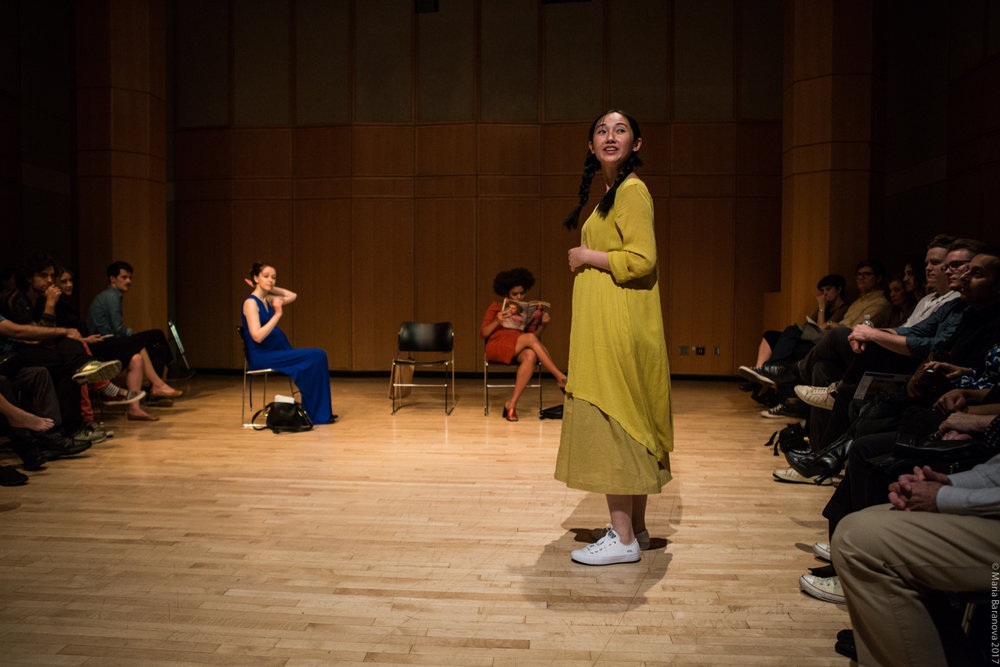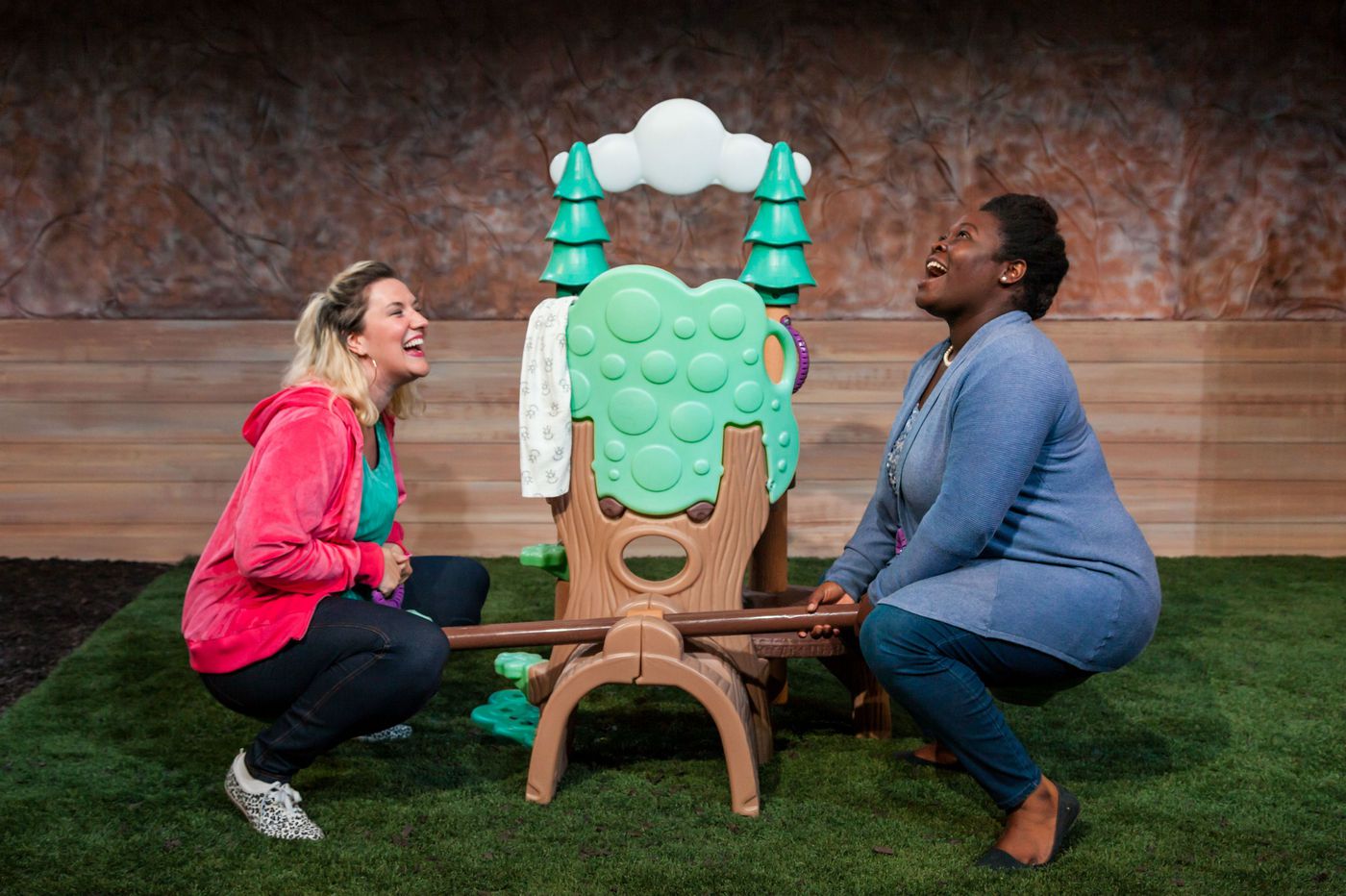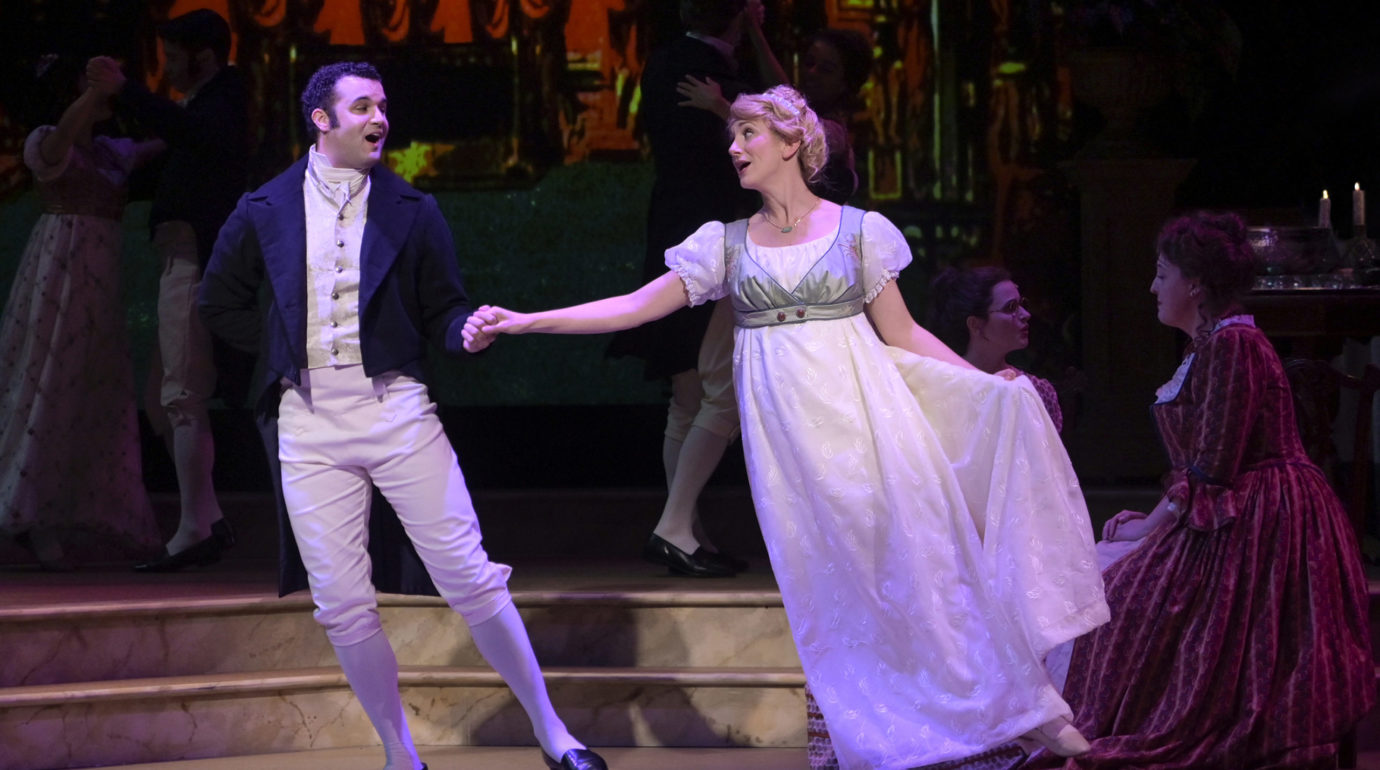Sharon Rietkerk has graced the stages of TheatreWorks Silicon Valley numerous times, and has donned a prop pregnancy belly under costumes more than once. She played Chaya, a woman about to give birth by the end of the musical Triangle, as well as Meg, the March sister who is pregnant in the second act of the musical adaptation of Louisa May Alcott’s Little Women. This month, Rietkerk is returning to TheatreWorks—but with a difference. She’s playing Jane Bennet in Paul Gordon’s musical adaptation of Jane Austen’s Pride and Prejudice. And while the eldest Bennet sister is definitely not pregnant in this tale of love and deception, this time Rietkerk herself is.
“I guess you’d call this non-traditional casting,” says Robert Kelley, the artistic director of TheatreWorks, who has led the company for 50 years. He notes that he cast Rietkerk before she was pregnant and that she offered to leave the show when she found out. “That’s not the way we felt it should go,” he says. “We believe our audience will understand that we’re making room for a brilliant actress to continue her career in a role for which she’s perfect, and that’s something we’re quite proud of.”
Rietkerk had wanted to stay on, especially because this is Kelley’s last season as artistic director, but was concerned that her baby bump would disrupt the look of the Regency-era play. “It didn’t feel right to just show up with this surprise, especially for our wardrobe department,” Rietkerk says. “Jane’s very much a pure, period ingenue.” While Kelley notes that the empire waist of the Regency costumes actually allow Rietkerk to blend in with her fellow non-pregnant actors, it doesn’t seem like it would have mattered to Kelley if she did stick out. “We think having Sharon in the cast regardless of her pregnancy is very representative of TheatreWorks and the way we approach making art.”
Kelley has directed pregnant actors before, and the TheatreWorks wardrobe crew even altered costumes weekly for actor Livia Genise when she was pregnant in the company’s first production of Rags. TheatreWorks has accommodated artists’ families in their housing opportunities, and Kelley keeps a box “full of items that are only of use to 2-year-olds.” The warm welcome for artists who have or are about to have children is not necessarily commonplace across the field, especially for those whose work depends in part on their appearance.
“It’s the one industry where you’re allowed to discriminate against bodies,” says Rachel Kauder Nalebuff, who wrote the play The Bumps specifically for three pregnant actors. Her initial inspiration was not her own personal experience but simply a question that may be familiar to many artists creating a theatre piece: How do bodies relate to this space? Kauder Nalebuff, who is also the director of the Brooklyn-based alternative theatre publishing house 3 Hole Press, says that most people who saw or read about The Bumps assume that she developed the work while pregnant herself. On the contrary, she says, she and director Deena Selenow felt privileged as non-pregnant artists “to carry this space because we had the time and resources and energy” that many working parents and pregnant people lack.
The Bumps grew from museum spaces in Los Angeles—chosen initially because they offered more childcare resources than their theatre counterparts—to readings in New York, including a benefit for Planned Parenthood in 2017. The flow and energy of the piece changed, as did the cast; the characters of 3 months, 5 months, and 7 months rotated up and out of the production throughout their pregnancies. Kauder Nalebuff and Selenow envision an ideal nine-month run in which audiences can “watch actors graduate as their bodies evolve,” Kauder Nalebuff says. Script revisions and cast adjustments weren’t the only changes to The Bumps process: At the Planned Parenthood benefit and the Prelude Festival in October 2017, Selenow herself was directing while pregnant.

“I didn’t tell anyone until I was five months pregnant,” Selenow says. She was also working in academia and feared her colleagues “would be annoyed or mad or get anxious. And I was also afraid that I wouldn’t get directing jobs.” Her feelings were in direct contrast to the advice she had shared with the company of The Bumps, as she listened to actors debate the consequences that could arise when they inevitably had to reveal their pregnancies to their agents. (Selenow and Kauder Nalebuff found their first cast via a Facebook post calling for pregnant actors.) “All these things that I had been in the room saying with other women, trying to be confident, trying to advocate for others, saying, ‘Be your full self!’—then I was feeling all of those fears.”
Erica Lee Haines, an actor and director who has recently taken the reins as the Parent Artist Advocacy League (PAAL) regional representative for Nashville, felt similarly when she was debating acting jobs while pregnant with her daughter Rosemary. “I didn’t want to be a burden,” Haines says. “I didn’t want to be that girl who needed all these special things, and I wanted to be able to work afterwards and not be labeled hard to work with.” She did take a directing job with Act Too Players in Franklin, Tenn., while pregnant, which she said made her reconsider how rehearsals and breaks are structured for able-bodied artists who weren’t pregnant or nursing. “You can’t pump [milk] in ‘fives’ or ‘tens’,” she relays, a frustration echoed by Selenow, the new L.A. regional PAAL representative, who’s been in audition rooms that have refused to hold for her to pump before bringing in more actors.
Ultimately the development of The Bumps led Selenow and Kauder Nalebuff to reexamine theatre through the lens of labor politics (pun fully intended). Kauder Nalebuff, who spent years as a feminist organizer, found that pregnancy is a microcosm of the ways the theatre industry shuts out people whose time—their day job, their child- or eldercare responsibilities, their commute, their bodily needs—does not or cannot adhere to the traditional model of working theatre.
“Parenthood exposes how the theatre isn’t friendly to people with regular schedules,” Kauder Nalebuff says, noting that pregnancy is one component of the field’s larger conversations on inclusion. “You can’t look at pregnancy without looking at parent inclusion. Pregnancy is a transient political experience.”
This wider conversation particularly resonates for pregnant artists who are transgender or gender-nonconforming (TGNC). “Pregnancy and parenthood can be very isolating, and I think TGNC folks experience that isolation tenfold,” says Fly Jamerson, a GNC dramaturg and playwright based in Lincoln, Neb. Jamerson is currently directing a show, workshopping a play, teaching at Doane University—all while they’re five months pregnant. “For most of this pregnancy, I refrained from sharing my future parenthood with my colleagues and friends in fear of judgment, discrimination, and gender erasure,” Jamerson says. “It’s amazing to see parent artist advocacy groups on the rise, but when the focus or the image skews toward motherhood, I don’t know where or if I fit into that group.”
“When I found out I was pregnant, I realized I still associate pregnancy with womanhood,” adds Natalie Elder, a nonbinary producer and writer. Both Jamerson and Elder note that the simple addition of gender-inclusive language can make a world of difference, such as substituting “parental leave” for “maternity leave.”
Every person I spoke with for this piece, regardless of gender identity or role in the theatre field, expressed anxiety that their pregnancy would blacklist them from working in the future. Even with the support of TheatreWorks behind her, Rietkerk worries she won’t be hired again once she gives birth. “My biggest fear is that someone will say, ‘She had a baby, so she probably won’t want to do this show’, or they won’t even call me in to audition because they make assumptions about my inclinations that I never even get a chance to voice.”
“Once I started to show, I got a lot of comments about when I was going to quit, and was I going to give up theatre,” says Jasmine Joshua, a nonbinary producer and director who founded Seattle’s Reboot Theatre Company while pregnant with twins. Joshua recalls an acting teacher asking them to sit out a Viewpoints class out of ability concerns. “I remember thinking, ‘Look, I’m growing two human beings right now, I think I can handle walking in a straight line.’”
The assumption that pregnant people are somehow weak leads many to push themselves too hard in response. Tamanya Garza, a director who serves as the PAAL regional representative for Philadelphia, was president of the board of Azuka Theatre while she was pregnant, and attended a board meeting the night before she was due. Garza says the pressure she put on herself to compartmentalize her pregnancy speaks to the lingering expectation in our culture that once someone has a child, they will “either take no interruption or totally disappear. You try to work until the last second, at the hospital, on leave.”
Garza channeled her experiences into directing Molly Smith Metzler’s postpartum dramedy Cry It Out at Simpatico Theatre last summer. “I cast a Black woman [in Cry It Out] because she talks about a traumatic pregnancy,” Garza says, noting that dramaturgical material in the program cited mortality rates among Black parents. She says that her work before and after her pregnancy has given her a new perspective on the logistics of life in the theatre for current and future parents. “We accommodate so many other things. Why not this?”

The biggest barrier to any parent returning to work in our nation, regardless of the industry, is childcare. PAAL gives childcare grants to theatre companies to hire caretakers for children of the cast, creative team, and audiences; Garza and Simpatico received a grant for Cry It Out, and Haines notes that Pipeline-Collective’s Dec. 11 benefit performance in Nashville will also offer free childcare. But the problem is systemic, and impacts parent artists from community to commercial theatres. Mimi Lien, a Tony-winning scenic designer who worked at La Jolla Playhouse’s Without Walls Festival while seven months pregnant with twins, notes that a lack of childcare hinders everyone from newcomers to artists with established careers. In between tech rehearsals for Moby-Dick at the American Repertory Theater, Lien shares that four members of the creative team have children under 2.
“We were chatting and we were sort of like, ‘Wouldn’t it be great if every institution had childcare?’” she says. “People keep asking me, ‘Are your babies gonna come visit and see what you’re doing?’ No, because while I’m here my husband is splitting taking care of [the twins] and working. It’s not feasible.” Lien says her union hasn’t been forthcoming with resources on childcare or parent inclusion initiatives; when I told other artists that their respective unions likely had committees on or for working parents, they were similarly unaware.
“We’ve started to engage with unions on pregnancy rights education for staff and representatives,” says Rachel Spencer Hewitt, the founder of PAAL. An actor and activist, Spencer Hewitt has grown PAAL from a blog of communal stories to a robust organization whose first national summit on parent inclusion in the arts is this week (Friday, Dec. 6) in New York City. “I’ve gathered a cohort of union reps, lawyers, and human resources professionals to guide me on curating resources for every parent who reaches out, especially those with questions on pregnancy rights. We also have a discrimination survey where pregnant individuals can submit their stories anonymously.”
While current and future artist parents best know the ins and outs of parent inclusion, the struggle cannot rest solely on their shoulders. “This is not a problem for parents to fight—it’s for all of us,” Garza says. With the help of PAAL and individual theatre companies and artists, the conversation is at least moving forward.
“Maybe next year Sharon will be back at TheatreWorks with a child accompanying her,” Kelley says. “That’s something we’d be equally proud of.”


